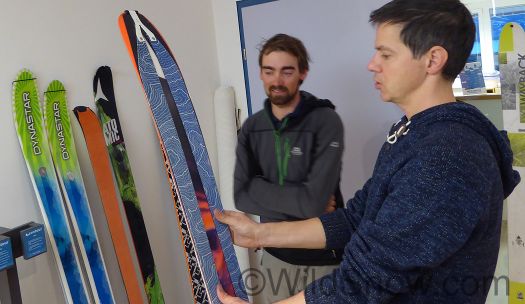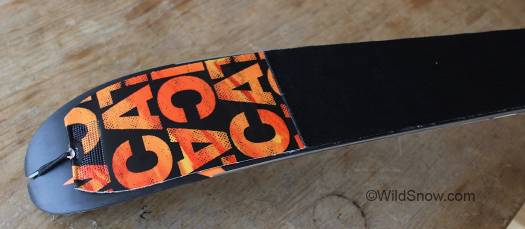Consider bikinis. For something that’s just a few square centimeters of textile the variety is nearly infinite. I’m not sure ski climbing skin shaping reaches that same level of “artistic” eventuality, but you can get creative if you want (and utilize more fabric than a bikini in most cases). Depending on your goals and style, climbing skin shapes go from racing straight and skinny “gliders” all the way to wall-to-wall carpet that grips like bear claws.

Top skin has straight cut tip, sidecut shaped waist and tail. Skin on lower ski is “bikini cut” with heavy taper at both tip and tail, used on ski with quite a bit of rocker.
A few things we’ve seen in skin shaping over past few seasons. Commenters, got any tricks?
1. Classic cut, follows ski sidecut without much ptex showing at tip or tail. Best climb performance but extra weight and glide resistance for ski touring, especially in the case of heavily rockered skis that don’t get much tip or tail traction anyway.
2. Straight at tip, tapered and shortened at tail. My favorite climbing skin shape. I feel that the straight cut tip has best combo of glide and climb, though it still might be more than needed under a rockered tip. Photo above shows straight trim at the tip.
3. Bikini cut, heavy taper at tip and tail, short at tail. Best reduction in weight, but I feel the heavily tapered tip might have more slide resistance than a straight cut tip due to the taper working against the snow. See photo above.
4. Skinny skin, straight cut. Super skinny (as in just a few centimeters) can be useful for long flat slogs, semi-skinny for skimo racing. When you get into reduced sizes, cutting the carpet quite short and not using a tail fix is common, especially in skimo racing. Bear in mind that racers sometimes carry two or more sets of skins and that having a tail fix compensates somewhat for glue failure.
5. Split skins can be cut with a somewhat generic sidecut radius and adjusted to fit different backcountry skis. They save significant weight with wider planks, though climbing grip is sometimes compromised and you’ll feel a lack of glide in some conditions due to the slot created by the two strips of skin.

Werner Koch of Contour Skins showing us how the Contour ‘Hybrid Free’ split skin works.
6. Climbing skins such as the Atomic Ultimate Rocker and G3 Scala have tip sections made of materials other than fabric. Atomic has a section of lighter weight material that’s glide proficient. Scala has a section of fish scaled plastic that’s said to help the skin climb but has about the same mass. Jury is out on both but it’s nice to see innovation. Yes, we’re talking more about skin material than shape, but I figured I’d throw that in since these tips can probably be cut in innovative ways the future will bring.

Atomic rocker skin has glide tip that might allow creative shaping, is made by Contour. I’d like to see a version of this with the slick surface running to about 20 centimeters from the boot position, to create a “kicker” skin with super glide.
7. Then there is the outlier. Profoil and other skins cut to the full ski width. Fisher’s plastic climbing skin is proving to be useful, but storage challenges are problematic (it sticks to itself too well). I include here as in illustration of “full cut edge to edge” skin shaping. In other words, you don’t leave any offset exposing your ski edge. If you mostly skin powder you can do this with regular carpet skins as well — you’ll be surprised at how well they work. But be ready for some startling behavior if you try to edge on hard snow, especially in situations when you leave your skins on for downhill on hard snow.
Check out all our climbing skin coverage.
WildSnow.com publisher emeritus and founder Lou (Louis Dawson) has a 50+ years career in climbing, backcountry skiing and ski mountaineering. He was the first person in history to ski down all 54 Colorado 14,000-foot peaks, has authored numerous books about about backcountry skiing, and has skied from the summit of Denali in Alaska, North America’s highest mountain.

